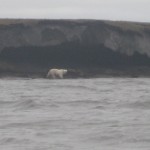A northern journey along the DEW Line
December 22, 2010
907-474-7468
12/20/2010
On windy, cold nights a few decades ago, men in darkened rooms north of the Arctic Circle spent their evenings watching radar screens. They were looking for slashes of green light that represented Soviet Bear bombers loaded with nukes and headed southward from the pole. Those men were DEWliners: a group mostly comprised of civilians who had signed 18-month contracts to work at radar sites that stretched across the Arctic like an electronic picket fence.
There were stations every 50 miles from the Aleutians to Greenland. The Distant Early Warning Line stations remained in a chain along 69 degrees north latitude even as they became somewhat obsolete after Russian development of intercontinental ballistic missiles.
Now, long after the thaw of the Cold War, some of the DEW Line stations have been upgraded to modern radar systems. Others are moldering on the muskeg of Canada and northern Alaska. Stacey Fritz has walked through more than one dozen DEW Line sites, talking with people who worked and lived in and near them.

Fritz has camped on gravel bars with fog-obscured views of DEW Line towers and golf ball-shaped radomes. More than once during her research, she felt the terrifying thrill of being pursued by a polar bear.
Now at the far end of a unique experience, Fritz recently defended her doctoral thesis in anthropology at the University of Alaska Fairbanks: "DEW Line passage: Tracing the legacies of arctic militarization."
As her title suggests, Fritz is interested in the cultural and environmental impacts of the U.S. government's establishment of 70 lonely outposts in the high arctic, which she likened to overseas military bases. One of the stations was actually named Lonely.
During her presentation, Fritz showed images and videos of contaminate-laden DEW Line dumps eroding into the sea. She described how the northern tundra at the sites probably absorbed more spilled fuel than you will burn in your lifetime.
Fritz also explained the effects of staggering amounts of alcohol imported to places like the Barter Island Social Club, and described how American citizens at Kaktovik in 1947 had their homes bulldozed away to accommodate a landing strip needed to build a Dew Line station.
Fritz summed up her presentation by saying that she "hopes her thesis helps in deconstructing militarized notions of security."
Her work may yet help accomplish that goal, but the academic is a small part of the execution of her research. Fritz found that as she and life partner Ryan Tinsley sailed and paddled their canoe along the northern coast of Alaska, "most people were far more interested in our trip than in my study."
She and Tinsley, a Fairbanks builder and adventurer, devoted two summers to sailing the entire northern coast of Alaska, stopping at as many DEW Line sites as they could along the way.
They purchased a tandem expedition canoe and fitted it with two sails and an outrigger. In late June 2008, a friend gave them a ride up the Dempster Highway in the Yukon Territory, where they slid their boat into the Peel River.
The Peel floated them to the Mackenzie River, which ushered them to the Beaufort Sea. Soon after, they landed at Shingle Point, the first of many DEW Line sites they would visit. Fritz and Tinsley spent that summer and the next sailing and paddling westward along the coast.
They covered more than 700 miles to Wainwright, Alaska. Along the way, as Fritz detailed on www.tundradaisy.org, they once hoisted a sail to outrun a polar bear that was swimming toward them.

Another time, they were transported off a gravel bar near Prudhoe Bay by oil company workers and escorted, boat and all, to a beach further west. And, after being "adopted" by Roy and Flossie Nageak when they first landed near Barrow, Fritz and Tinsley helped butcher and distribute a bowhead whale.
While her primary method of travel made it more difficult to obtain funding, Fritz said her sailing trips "really paid off" for her research. She interviewed more than 40 people for her dissertation, many of whom live in villages near DEW Line sites.
Arriving by canoe perhaps made her accepted more quickly than if she had just stepped off a plane from Fairbanks. "It probably gave me a little extra village cred(ability)," Fritz said.
This column is provided as a public service by the Geophysical Institute,
University of Alaska Fairbanks, in cooperation with the UAF research
community. Ned Rozell is a science writer at the institute.


